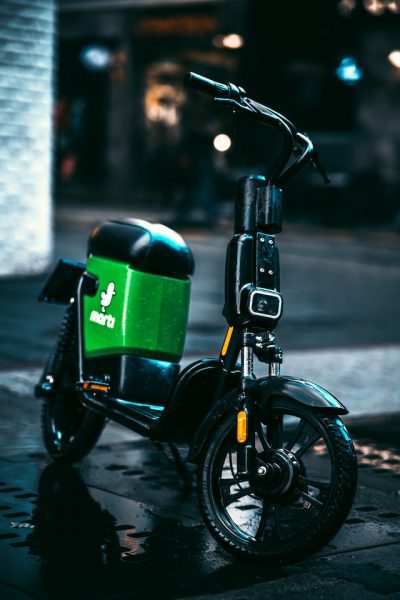Riding a scooter can be an enjoyable and convenient way to get around, but when it comes to wet surfaces, special caution must be taken. As part of FamilyHype’s mission to promote harmlessness for all, we have compiled a list of essential tips for riding a scooter on wet roads.
From proper maintenance of your scooter to improving your skills, choosing the right gear, adopting safe riding habits, and understanding the road conditions, these safety tips will help you and your family stay safe.

When it comes to wet surfaces, scooters are considered a type of electric vehicle, which means that proper maintenance is essential. Checking the battery, brakes, tires, and lights regularly will help ensure that your scooter runs smoothly and safely. Additionally, make sure to wear a helmet and other protective gear, such as gloves and elbow pads, to keep you safe in the case of a fall.
Improving your skills is also key to riding safely on wet roads. Take the time to practice your balance and maneuverability in a safe environment, such as a parking lot or empty street. Additionally, make sure to keep an eye out for slick spots, puddles, and other obstacles. Finally, pay attention to the weather forecast and road conditions prior to riding. Wet roads tend to be more slippery than dry, so exercise caution at all times.
Adopting safe riding habits is also essential. Be aware of your surroundings and the other vehicles on the road. Avoid sudden changes of direction, especially on wet surfaces. Always be sure to maintain a safe speed and keep your distance from other vehicles. Finally, be sure to obey all traffic laws and regulations.
At FamilyHype, we are dedicated to promoting harmlessness for all. We hope these tips will help you and your family stay safe when riding a scooter in damp areas and in rainy weather. If you have any feedback or questions about this article, please don’t hesitate to share them with us.
Key Takeaways

Basically, riding a motorized, electric, kick, or push scooter on wet surfaces can be risky, and it’s important to take extra precautions and protection into consideration. At FamilyHype, we strongly emphasize the importance of understanding the road conditions and prioritizing safety. Wearing a helmet, protective jacket, pants, and gloves is essential, as is checking the brakes and tires before riding to ensure good traction and a safe ride. Additionally, being aware of your surroundings, obeying traffic laws, and never riding too fast are key protection tips for riders.
Let’s always remember that riding a scooter is not just about getting from point A to B; it’s about doing so safely and responsibly. We hope this article gave you some helpful tips for riding your favorite two-wheeled companion on wet surfaces. If you have any questions or feedback, please don’t hesitate to contact us here at FamilyHype.
Understand The Risks
Riding a scooter on wet surfaces can significantly increase the risk of an accident due to reduced traction and visibility. As a result, it’s important to practice Risk Awareness, particularly in Wet Conditions.
At FamilyHype, we care deeply about promoting protection and preventing potential harm. Let’s take a closer look at how to properly maintain your ride to reduce risks and keep your family safe.
When it comes to harmlessness, understanding the risks associated with riding on wet grounds is essential. Wet grounds can reduce traction and visibility, increasing the chances of an accident. It’s important to stay aware of the risks and take precautions to ensure your family’s protection.
Additionally, by properly maintaining your ride, you can further reduce the risks associated with wet weather riding. This includes regular inspections and maintenance, such as checking the brakes, tires, and other components for wear and tear.
When riding in wet conditions, it’s important to wear the proper gear and use caution. This includes wearing a helmet, gloves, and appropriate clothing. It’s also important to be aware of your surroundings, such as the roads and traffic, and to always follow the rules of the road. By understanding and following the risks associated with riding in wet conditions, you can help ensure your family’s protection.
At FamilyHype, we believe in helping families stay safe and healthy. We strive to provide the latest family safety information and resources to our readers, so they can make informed decisions about their family’s harmlessness. We hope this article has helped you better understand the risks associated with riding a scooter in wet weather and how to properly maintain your ride to minimize those risks.
Maintaining Your Scooter
As we venture into the world of scooter riding, let’s not forget the importance of regular maintenance to ensure our protection and prolong the life of our favorite rides.
Checking our tires regularly is crucial as worn out or poorly inflated tires can lead to accidents and damage to your two-wheeled companion.
Equally important is ensuring that our brakes are functioning well because having efficient stopping power can be a lifesaver in critical situations.
Regularly Check Your Tires
Don’t underestimate the importance of regularly checking your tires, it’s a crucial step to ensure your protection when riding on wet surfaces. Monitoring tire pressure and understanding replacement frequency can help us prevent accidents.
Remember, well-maintained tires provide better traction in the rain. So let’s take care of each other by keeping our rides safe.
Now, let us move on to another significant area: ensuring that our brakes are functioning optimally. While this content isn’t specifically for gas-powered scooters, it’s important for all owners to stay aware of the importance of regularly checking tires.
As members of the FamilyHype community, we encourage you to share your feedback and experiences with us.
By staying mindful of the tires, we can ensure that our rides are safe, secure, and enjoyable.
Ensure Your Brakes Are Working Well
Making sure your brakes are in top-notch condition is a must for all scooters, particularly when riding on slippery roads. It’s all about ensuring harmlessness and preventing accidents due to weather impact. Remember these key points:
- Regularly perform brake adjustments.
- Check for any brake wear or damage.
- Test your brakes before riding.
- Be aware of how wet conditions affect braking distance.

Source: Pexels.com
Other things you need to check include:
- Battery: power source type, wattage
- Motor: size, type
- Wheels: diameter, treads
With this in mind, it’s important to remember that scooters and brakes are interconnected, as the brakes are a crucial part of the scooter’s safety.
Improve Your Riding Skills
Honing your riding skills is essential to staying safe when cruising on wet surfaces, and FamilyHype is dedicated to helping you do just that. Balance training and skill enhancement should be a priority, and mastering these attributes will help us navigate slick conditions with greater confidence and agility.
After all, we want to serve our community by promoting harmlessness first, right? That’s why we encourage you to share your feedback and experiences with us to help others learn how to ride an electric scooter safely in wet weather.
When it comes to selecting the appropriate gear for rainy weather rides, there are a few important things to consider. First, it’s important to choose a ride that offers good traction, such as one with pneumatic tires. This is one of the most important rain features of your ride for protection. You’ll also want to look for features such as a wide, stable base and increased weight capacity to help you maintain control. Finally, make sure your ride is equipped with sturdy brakes that can handle wet pavement.
With the right gear, you can enjoy a safe and enjoyable ride.
The Right Safety Gear
As we venture into the realm of scooter riding, it’s crucial that we prioritize protection first by choosing the right gear. We can’t stress enough how important it is to wear a high-quality helmet; its role in protecting our heads during potential accidents is irreplaceable.
Additionally, using reflective clothing for visibility isn’t just a fashion statement but a lifesaving choice, especially when riding in low-light conditions or at night.
Wear A High-Quality Helmet
At FamilyHype, we believe in the power of the family unit and safeguarding lives, which is why we want to stress the importance of wearing a high-quality helmet when scooting around on wet surfaces.
Helmet Types, such as full-face, open-face, half-shell, or modular helmets, can make all the difference in providing protection during slips or falls. It’s essential to make sure the helmet is properly fitted, as this ensures the best possible protection.
We urge you to consider your harmlessness and the harmlessness of others when out on your ride – wear a high-quality helmet and consider reflective clothing for enhanced visibility on wet roads.
Let us know your experiences and opinions in the comment section below.
Use Reflective Clothing For Visibility
Having discussed the importance of wearing a high-quality helmet, let’s move on to another crucial aspect – visibility. When riding, we must ensure that we’re easily noticeable by other motorists.
Wearing reflective, weatherproof clothing and using visibility gadgets can dramatically increase our visibility. These precautions show respect for everyone on the road, and FamilyHype encourages its readers to share their feedback, experiences, and opinions on this topic.
Reflective Clothing (having bright colors and reflective material to enhance visibility in low-light conditions), Visibility Gadgets (like lights, reflectors, and bells to alert other motorists of their presence), and Weatherproof Clothing (clothing designed to stay dry and keep the rider warm in wet conditions).
By using these visibility safety gear, riders can help protect themselves and other motorists on the road. Adopting these safe riding habits significantly contributes to everyone’s well-being.
Adopt Safe Riding Habits
You’ll feel a whole lot safer and more confident riding your two-wheeled companion on slippery surfaces when you adopt safe riding habits. This FamilyHype article focuses on scooters and the importance of adopting safe riding habits to ensure our safety and that of others on the road.
Scooters are motorized vehicles with two or three wheels, thus, they come with inherent risks. Riding habits are responsible practices that create a safe environment, safety is protection from harm, and road conditions include the terrain, weather, and other variables that can affect the ride.
To ensure our safety, we must practice defensive driving to anticipate potential hazards, control our speed, especially in corners and turns, and regularly maintain our scooter for optimal performance. Moreover, by cultivating these habits, we not only ensure our safety but also contribute to the welfare of others on the road.
We hope that by reading this article, you have gained an understanding of why it is important to adopt safe riding habits.
Next, let’s delve into understanding road conditions better.
Know The Road
It’s essential for anyone riding any vehicle to familiarize themselves with the road conditions before heading out. Weather conditions can make roads slippery and difficult to navigate. We need to be aware of potential hazards such as puddles or ice patches that could be lurking around corners. By being more attentive to road conditions, we can make your rides safer in wet weather, setting an example for others.
As this article is about scooters, it’s important to note that this content doesn’t apply to gas-powered ones. Here at FamilyHype, our writers and editors are either parents or people who highly value the family unit. We hope that this article is helpful to you and would love to hear your feedback about the content, your experience, or your opinions.
Conclusion
In conclusion, riding a scooter on wet surfaces can be risky. To mitigate these risks, it’s important to maintain our rides properly, hone our riding skills, wear the right gear, and adopt safe riding habits.
At FamilyHype, we strongly emphasize the importance of understanding road conditions and prioritizing safety. Let’s always remember that riding a scooter isn’t just about getting from point A to B; it’s about doing so safely and responsibly.
Whether it’s motorized, electric, kick, or push scooter, they should all be handled with extra caution on wet surfaces. Riders should wear a helmet, protective jacket and pants, and gloves, and take note of the weather conditions.
Additionally, make sure to check the brakes and tires before riding to ensure good traction and a safe ride. Always be aware of your surroundings, obey traffic laws, and never ride too fast.
Frequently Asked Questions
How Do I Protect My Scooter From Water Damage?
To protect your ride from water damage, avoid riding it in heavy rain or during bad weather (or just generally rainy conditions). If caught in a light sprinkle or encountering water splashes, ensure your ride is water-resistant, especially the electric scooter’s internal parts and electrical components. To prevent water damage during cleaning, use a damp cloth or sponge with mild soap and water, avoiding high-pressure water jets that could potentially damage sensitive electrical parts.
Can You Ride A Scooter On Wet Surface?
While you can ride a scooter on wet ground, it’s essential to be cautious, especially during rainy conditions or torrential rain. The wet ground can reduce the wet scooter’s braking distances and traction, making it more challenging to stop quickly or maintain stability. To protect your ride from water damage, avoid riding in heavy rain or fully submerged areas unless it is specifically designed for water resistance, such as some e-scooter models.
How Do I Make My Scooter Rainproof To Ride On Wet Surfaces?
To make your electric scooter waterproof, water-resistant or even rainproof, look for electric scooters with water-resistant features or good IP ratings, indicating their level of protection against water ingress. Additionally, you can apply water-resistant coatings or sprays on vulnerable parts of the scooter, such as the electrical components and connections. Follow proper maintenance and safety guidelines, and when riding an electric scooter in the rain, exercise caution, especially on wet surfaces, to ensure your scooter’s safety and prevent potential damage.
How Do You Use A Scooter In The Rain Or On Wet Surfaces?
When using a scooter in the rain, be cautious and adjust your riding style to ensure safety on wet surfaces. Avoid riding in heavy rain or through low-pressure water jets, as these conditions can lead to water ingress and potential damage to the scooter’s electrical components. Watch out for solid objects or obstacles hidden by the rain, and if your ride has a specific ingress protection rating, follow the manufacturer’s guidelines to maintain its water resistance during rainy conditions.
Can I Leave My Scooter In The Rain Or On Wet Surfaces?
Leaving your ride in the rain is generally not recommended, even if it is water-resistant. Prolonged exposure to water, especially through low-pressure water jets, can still lead to potential damage to its electrical components over time. To ensure the safety and longevity of your ride, it’s best to store it in a covered and dry area when not in use, protecting it from the elements and minimizing the risk of water-related issues.
How Do I Protect My Motorcycle From Rain?
To protect your ride from rain, you can use a waterproof cover specifically designed for e-scooters. Ensure the cover fully encapsulates your ride, safeguarding it from direct exposure to rain and moisture. Additionally, practice safety riding on wet surfaces by adjusting your riding style, avoiding sudden braking or sharp turns, and maintaining a safe distance from vehicles to minimize potential hazards during rainy conditions.
Are Electric Scooters Resistant To Rain?
They are generally designed to be water-resistant, allowing them to withstand light rain or splashes without significant issues. However, not all of them are fully waterproof, and exposure to heavy rain or submersion in water can cause damage to the electrical components. It’s essential to check the manufacturer’s specifications for the scooter’s water resistance capabilities and exercise caution when riding in wet conditions to ensure your ride remains in good working condition.
Is The Xiaomi Scooter Waterproof?
The Xiaomi electric scooters are designed to handle light rain during rides without issues. However, they are not fully waterproof, so riding in heavy rain should be avoided to protect the scooter’s battery and sensitive components from potential water damage. It’s essential to take precautions and store the scooter indoors or in a dry place when not in use to prolong its lifespan and maintain the battery’s health.
How Do You Stay Dry On A Scooter?
To stay dry on an electric scooter in the rain, it’s crucial to consider the scooter’s ingress protection. Ensure your scooter has a high IP rating, which indicates its resistance to water and dust. Additionally, invest in a quality rain poncho or waterproof gear to keep yourself dry while riding an electric scooter in wet conditions. Ride an electric scooter at a slower and more controlled speed can also help minimize splashes and maintain your comfort when using an electric scooter in the rain.
How Do I Keep My Scooter Outside Especially On Wet Surfaces?
To keep your scooter outside, even in light rain, prioritize water resistance. Opt for a scooter with waterproof features and consider a weatherproof cover. Additionally, follow safety tips like placing it on a level surface to prevent tipping. Be cautious of pressure water jets, as they can damage electronic components. When riding in the rain, maintain a steady and controlled pace to avoid accidents.
DISCLAIMER (IMPORTANT): This information (including all text, images, audio, or other formats on FamilyHype.com) is not intended to be a substitute for informed professional advice, diagnosis, endorsement or treatment. You should not take any action or avoid taking action without consulting a qualified professional. Always seek the advice of your physician or other qualified health provider with any questions about medical conditions. Do not disregard professional medical advice or delay seeking advice or treatment because of something you have read here a FamilyHype.com.

